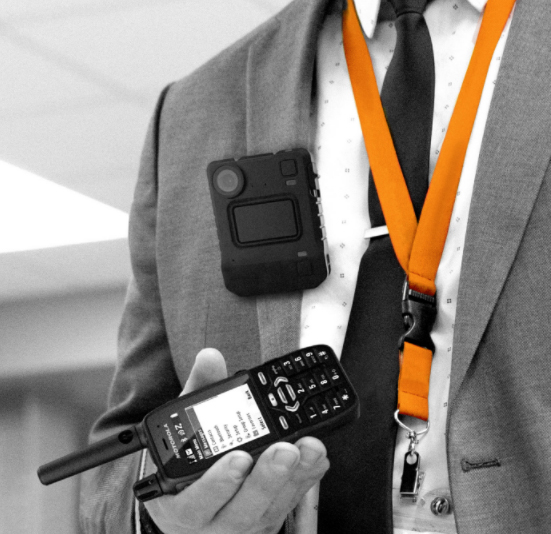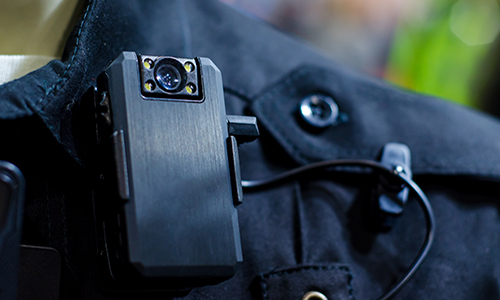The body-worn camera market was valued at USD 1.62 billion in 2020 and is expected to reach USD 424.63 billion by 2026 — a 155.5% compound annual growth rate (CAGR) during the forecast period (2021-2026), according to Mordor Intelligence. Although still in its infancy compared to many other safety systems, this wearable technology is an emerging trend in K-12 schools, colleges and hospitals.
Campus Safety’s 2021 Video Surveillance Survey found the percentage of respondents who have purchased body-worn cameras has more than doubled since we last conducted the survey two years ago. Nearly a third of all survey participants (30%) say they’ve purchased this type of equipment in the past two years, compared to only 14% in 2019.
Since more of our readers are adopting the technology or considering doing so, we wanted to chat with someone who understands the technology but is also familiar with the markets we serve. Enter Ryan Brady.

Brady was an educator for 19 years, including assistant principal at three schools where he headed campus safety.
Brady was a teacher for nine years, starting out as a special education teacher in 2002. He diligently worked his way up to assistant principal, serving at three different schools for a total of ten years. At each school, Brady was head of school safety. Brady also has an impressive 27 doctoral hours in statistics and used that knowledge to improve school safety.
“I don’t know what it was, but something about my persona led to me taking over school safety,” Brady told Campus Safety. “I did pretty much everything there is to do with school safety, from working with our fire inspectors to our SROs and our district office on our plans for missing students, real fires, mass shootings … I worked on day-to-day things too. We had a safety committee and would talk about the mental health of our students and how we can improve that, as well as physical health.”
After honorably serving students for 19 years, Brady took his talents to Motorola Solutions where he now sells body-worn cameras. School resource officers (SROs) in the schools he led used this technology, offering him a unique perspective in his new role. In his meetings with prospective clients, most seem to think the biggest benefit of the technology is the ability to capture people doing bad things. However, the biggest benefit of the technology, according to Brady, is mitigation and prevention.
“Some people say, ‘Well, you know, the purpose is to catch them when they’re doing wrong,’ and no, it’s not. The purpose is to prevent. When people do things wrong or issues occur, people get injured, people get in trouble. We don’t want that. We want to prevent those things from happening,” he said. “This is one of the very few safety measures that you can take that can prevent that. It does not allow somebody to lie about things after the fact.”
This doesn’t only apply to the people who are being recorded, but also the ones doing the recording.
“Now with law enforcement, through the years, we’ve seen mitigated risk. We have less complaints because we have law enforcement officers that know they need to toe the line because they’re being recorded. We have fewer incidents of injury because people are less willing to do stupid things when they’re recording themselves,” Brady said. “All of these things result in lower cost to our employees and a safer employee, all the way around.”
In Brady’s experiences, employees who would benefit greatly from body-worn cameras are those who work at points of entry.
“In schools, hospitals and colleges, how are people coming in? Most of our issues in a school would start there. Somebody would notice something wrong. Somebody would come in agitated. That point of entry is a huge place,” he said. “People that are right at the front or right there when somebody opened a door are also the ones that have the best chance of getting injured because they don’t know what situation is coming.”
Those who mostly work alone, like security officers, would also significantly benefit, says Brady. However, the technology isn’t only helpful for law enforcement or security personnel.
“Having been an adminsitrator, there’s about 300 times I can think in my recent memory that I would have loved to have a body-worn camera because it just does incredible things for mitigating concerns, issues, proving things, making things quicker,” said Brady.
The technology works as a force multiplier, he added, allowing individuals to feel protected if they don’t have support or backup from another individual.
“I was recently at a college that said the issue is that the kids know that they can just say [anything], so they have to send two security guards every time they go,” he said. “This is a way for them to be able to patrol the campus more broad and have people more active in different places and not having multiple people respond to one place at one time.”
Body Cameras Can Save Face, Time and Resources
Although Brady believes the main purpose of body-worn cameras should be prevention, the technology undoubtedly comes in handy for reviewing incidents after they occur.
In Brady’s career as an assistant principal, there were many instances where body-worn cameras protected his school and his employees. The first that came to mind is likely relatable for nearly any campus that uses the technology. A student had recorded a video of an SRO grabbing a student and cuffing them. The recording eventually made its way to the media and they “tore it up,” as Brady described.
When the sheriff asked school personnel what they planned to do with the involved SRO, the school said they were going to commend him and would be sharing the entire body-worn camera footage on their website. 
“What they failed to show was the 25 minutes before, the SRO worked really hard to get the student to comply, spent time and talked and talked. Until the student got combative, the SRO did not take any physical steps,” Brady said. “We now have a lot of people who are obviously bringing their cell phones out and recording incidents, but what they record is based on when they were brought into the fray or what they’re interested in showing. What they’re putting out, they’re going to trim their video by their interest level and that’s what the media gets a hold of. I believe strongly in the schools owning the narrative.”
In another incident, Brady said a student was handcuffed after becoming combative with staff, and the parents entered the school at the end of the confrontation and tried to intervene.
“They got in the middle of it and were trying to physically retrain us. Luckily, calmer heads prevailed and we were able to use that body-worn camera footage to show the parents the whole truth,” Brady said. “It wasn’t a ‘he said, she said’ incident. It was the actual facts. It wasn’t months of investigating to try to figure out the truth, interviewing people. It was just right there — immediate feedback.”
While these incidents are extreme examples where SROs had to resort to handcuffing students, Brady stresses that it is the last thing most want to have to do.
“I was very lucky to work with some great SROs that just did not want to handcuff. We don’t want to perp walk kids. We don’t want to do anything negative. The purpose of the SRO is to increase student interaction with law enforcement in a positive way. So the last thing you want to do is to be forceful.”
What Are the Drawbacks of Body-Worn Cameras?
Like with any technology, body-worn cameras also have limitations. Since it is a relatively new technology, although it isn’t as costly as many people think, it’s not inexpensive.
“I’m not going to lie to you, for good body-worn cameras, they’re not cheap, but they’re not as expensive as an overhead system,” Brady said. “For the price of our deployments, usually you can pay for a retainer for legal counsel, so if you can mitigate one lawsuit over the years, you probably have paid for the cameras multiple times over.”
While talking to potential customers, Brady said some have concerns about the limitations of the cameras as far as what they can do.
“They’re like, ‘Hey, can it see in the dark?’ No, it cannot see in the dark. ‘Hey, can we zoom in on this?’ No, we can’t. The purpose of that is a very good purpose, and that’s when that camera footage is shown to your boss or in a courtroom, we want you to see what the person saw, not an enhanced Superman version of that,” he said. “If you walk into a room and it’s dark and your camera can see through the dark and it can see a problem and you show that to a courtroom full of your peers, they’ll say, ‘Well, you could see it right there, why did you do that?’ It’s meant to mimic the human eye. It’s about safety of the employee.”
Common Mistakes Made by Schools Using Body-Worn Cameras
In his current role, Brady said the most common mistake he has seen campuses make in deploying the technology is not having policies in place that support the reasons why a campus chose to invest in them and also the logistics of its use.
“Your policies have to be clear on what the purpose is. Having been a boss for a very long time, you’re going to be concerned that you have people who are going to use it in a nefarious way,” he said. “What [are the ramifications going to be] if somebody doesn’t follow what you’ve asked them to do?”
Clients also tend to want to overuse the cameras, Brady said, which needs to be taken into consideration when creating a policy.
“I’ve had some clients that wanted to turn the cameras on all day, and I can understand that, but you have to be cognizant of things like people are human and they need to take bathroom breaks, so what’s your policy there?” he said. “If you set a policy that says you have to turn the camera on when you interact with a customer who is agitated and a person doesn’t do that five times in a row and they go, ‘Oh man, I forgot again.’ What’s your process going to be? Because if you don’t enforce that rule with that employee, the next employee is going to say, ‘Oh, this is easy. I don’t have to use this.’ You have to be able to stand behind your policy and enforce it.”
Lessons Learned as Both an End-User and a Salesperson
Having been a leader at schools where body-worn cameras were used and now selling them, the bottom line for Brady’s support of the technology is that it protects employees.
“I wish I had access to this technology when I was assistant principal. I love my students, but while they’re still waiting on that frontal lobe development and are the frog in the stork’s mouth, they will take you down to be able to go to prom. You’ll get accused of things and the number of times I can think that I could have turned the camera on and eliminated those concerns, it’s kind of tough,” said Brady. “All the people that we’re talking about today — cops, firemen, nurses, administrators — we all take a lot home with us. When you’re doing a job that you love for the right reasons and somebody does something negative to hurt you for their own self-purpose, a person that you’re trying to help, it really takes a toll on you.”
During his tenure as assistant principal, Brady dealt with many accusations made against employees by students. Although most were unfounded, he understandably had to go through the investigation process.
“If you can look at footage and you can make a determination in five minutes of somebody lying, rather than spending hours to review footage, to interview people, to make a determination, that’s a game-changer.”
Whether body-worn cameras or a different security technology, Brady urges school and healthcare employees to take the time to learn about new emerging technologies.
“Some are not as outside of the box as you may think, and you have to really think large picture. If something out there can save you a ton of time or can save your middle management a ton of time or stress or keep them in your employ, you need to consider that,” he said. “These are our employees, our most important thing. We can’t function without them. If you don’t take care of them and you can’t keep them safe or they don’t feel safe, they’re not going to be your employee long.”







